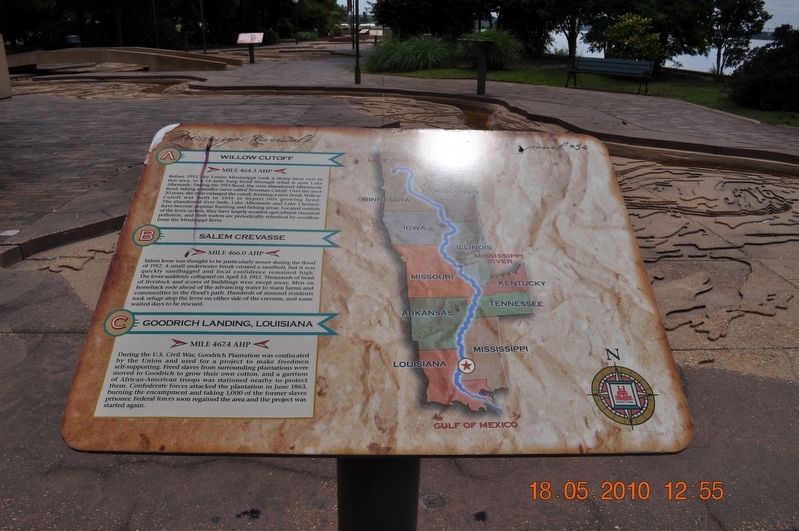Memphis in Shelby County, Tennessee — The American South (East South Central)
Willow Cutoff/Salem Crevasse/Goodrich Landing,Louisiana
Panel #34 Mississippi Riverwalk
Inscription.
A) Willow Cutoff
Mile 464.3 AHP
Before 1913, the lower Mississippi took a sharp turn east in this area, in a 14-mile long bend through what is now Lake Albemarle. During the 1913 flood, the river abandoned Albermarle Bend, taking a smaller curve called Newman Cutoff. Over the next 20 years, the river enlarged the cutoff, forming a new bend. Willow Cutoff was built in 1934 to bypass this growing bend. The abandoned river beds, Lake Albemarle and Lake Chotard, have been popular hunting and fishing areas. Located outside of the levee system, they have largely avoided agricultural chemical pollution, and their waters are periodically refreshed by overflowing from the Mississippi River.
B) Salem Crevasse
Mile 466.0 AHP
Salem levee was thought to be particularly secure during the flood of 1912. A small underwater break created a sand boil, but it was quickly sandbagged and local confidence remained high. The levee suddenly collapsed on April 13, 1912. Thousands of head of livestock and scores of the building were swept away. Men on horseback rode ahead of the advancing water to warn farmers and communities in the flood’s path. Hundreds of stunned residents took refuge atop the levee on either side of the crevasse, and some waited days to be rescued.
C) Goodrich Landing, Louisiana
Mile 467.4 AHP
During the U. S. Civil War, Goodrich Plantation was confiscated by the Union and used for a project to make freedmen self-supporting. Freed slaves from surrounding plantations were moved to Goodrich to grow their own cotton, and a garrison of African-American troops was stationed nearby to protect them. Confederate forces attacked the plantation in June 1863, burning the encampment and taking 1,000 of the former slaves prisoner. Federal forces soon regained the area and the project was started again.
Erected by Mississippi Riverwalk. (Marker Number 34.)
Topics. This historical marker is listed in these topic lists: Disasters • War, US Civil • Waterways & Vessels. A significant historical date for this entry is April 13, 1912.
Location. 35° 9.003′ N, 90° 3.489′ W. Marker is in Memphis, Tennessee, in Shelby County. Marker can be reached from Island Drive, 0.8 miles south of West A.W. Willis Avenue when traveling south. Located in Mud Island River Park. Touch for map. Marker is at or near this postal address: 125 N Front St, Memphis TN 38103, United States of America. Touch for directions.
Other nearby markers. At least 8 other markers are within walking distance of this marker. Tennessee River/Cumberland River (within shouting distance of this marker); Reelfoot Lake (within shouting distance of this marker); Palmetto Bend/Jackson Point/St. Catherine’s Creek/Ellis Cliffs (within shouting distance of this marker); Grand Gulf, Mississippi / Yucatan Cutoff / Big Black River (within shouting distance of this marker); Rodney Cutoff/Bayou Pierre (within shouting distance of this marker); Davis Island, Mississippi/Kents Island (within shouting distance of this marker); Vicksburg (within shouting distance of this marker); Young’s Point / Milliken’s Bend / Omega Landing (within shouting distance of this marker). Touch for a list and map of all markers in Memphis.
Also see . . . Battle of Goodrich's Landing. Goodrich's Landing was a cotton plantation owned by Henry Goodrich of East Carroll Parish, Louisiana. Situated on the west bank of the Mississippi River, the landing served as a shipping point for area cotton planters. When Union forces invaded the region in early 1862, they seized the plantation and established it as a base of operations in their advance against Vicksburg. As hundreds of escaped slaves flocked to the Union camp, neighboring plantation owners abandoned their properties and evacuated to the west, into Confederate held territory. (Submitted on March 27, 2018, by Sandra Hughes Tidwell of Killen, Alabama, USA.)
Credits. This page was last revised on August 27, 2020. It was originally submitted on March 27, 2018, by Sandra Hughes Tidwell of Killen, Alabama, USA. This page has been viewed 287 times since then and 43 times this year. Photo 1. submitted on March 27, 2018, by Sandra Hughes Tidwell of Killen, Alabama, USA. • Bernard Fisher was the editor who published this page.
Editor’s want-list for this marker. Wide shot of marker and its surroundings. • Can you help?
